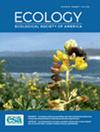玳瑁海龟的栖息地保真度
IF 4.3
2区 环境科学与生态学
Q1 ECOLOGY
引用次数: 0
摘要
气候变化正在改变栖息地的适宜性,并推动物种分布的变化。为了了解移动动物的潜在反应,有必要评估栖息地利用的可塑性水平,从短暂性到长期保真度。在这里,我们评估了玳瑁海龟(Eretmochelys brbricata)在觅食(我们的主要关注点)、迁徙和筑巢时对栖息地的保真度。在卫星追踪了来自西大西洋三个筑巢区的17只成年雌性后,我们在接下来的一年里重新追踪了它们。在15只海龟中,有足够的数据来评估年际觅食区域保真度,14只海龟返回相同的家庭范围,在连续的50%利用分布(UDs)之间表现出重叠;第15个人移动了10公里。保真度的平均精度(这里表示为连续觅食UDs的质心之间的距离)为1.45±SD 2.3 km,比许多卫星修复相关的误差小。我们还观察到,尽管在迁徙路线上存在明显的偏差,但它们对巢间栖息地范围和迁徙路径的保真度仍然存在。一个精确的栖息地保真度范例可能适用于成年玳瑁,但值得在生活史阶段和全球种群中进一步研究。我们的研究结果表明,成人的短暂性可能对预测的分布变化有有限的贡献。本文章由计算机程序翻译,如有差异,请以英文原文为准。
Habitat fidelity in hawksbill sea turtles
Climate change is altering habitat suitability and driving shifts in species distributions. To understand potential responses by mobile animals, it is essential to assess levels of plasticity in habitat use, ranging from transience to long‐term fidelity. Here, we evaluate the fidelity of hawksbill sea turtles (Eretmochelys imbricata ) to habitats used while foraging (our primary focus), migrating, and nesting. After satellite tracking 17 adult females from three Western Atlantic nesting areas, we then re‐tracked them in a subsequent year. Of 15 turtles with sufficient data to assess interannual foraging area fidelity, 14 returned to the same home range, exhibiting overlap between successive 50% utilization distributions (UDs); the 15th individual shifted <10 km. Mean precision of fidelity, here expressed as the distance between centroids of successive foraging UDs, was 1.45 ± SD 2.3 km—less than the error associated with many satellite fixes. We also observed fidelity to inter‐nesting home ranges and migratory pathways, though distinct deviations in migratory routes occurred. A paradigm of precise habitat fidelity is likely appropriate for adult hawksbills, yet merits further investigation across life history stages and global populations. Our results suggest that adult transience may have limited potential to contribute to projected distributional shifts.
求助全文
通过发布文献求助,成功后即可免费获取论文全文。
去求助
来源期刊

Ecology
环境科学-生态学
CiteScore
8.30
自引率
2.10%
发文量
332
审稿时长
3 months
期刊介绍:
Ecology publishes articles that report on the basic elements of ecological research. Emphasis is placed on concise, clear articles documenting important ecological phenomena. The journal publishes a broad array of research that includes a rapidly expanding envelope of subject matter, techniques, approaches, and concepts: paleoecology through present-day phenomena; evolutionary, population, physiological, community, and ecosystem ecology, as well as biogeochemistry; inclusive of descriptive, comparative, experimental, mathematical, statistical, and interdisciplinary approaches.
 求助内容:
求助内容: 应助结果提醒方式:
应助结果提醒方式:


